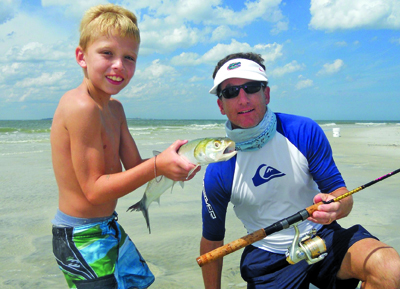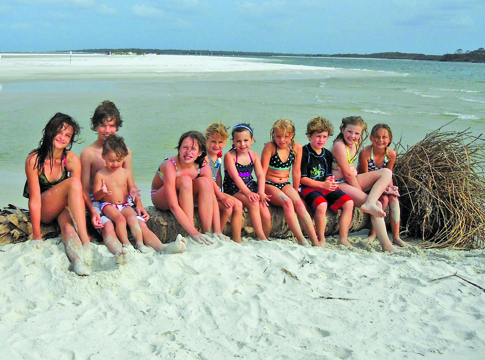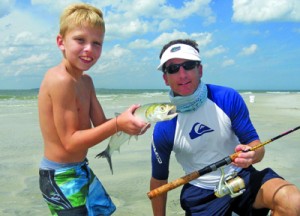Know the tides to enjoy the area’s inlets this summer

By Nathan & Ted Miller
Growing up in Jacksonville, I spent a lot of summer days fishing in the ocean. Friends and I would go look for tarpon along the beach. The air temperatures were in the 90s, and the water temperature was not far behind. We would fish until it was just too hot to take it anymore. We usually fished out of Mayport and the mouth of the St. Johns River. As we headed in, we would take a detour a few miles to the north and go beach the boat at the Ft. George River inlet. This is where we would cool off, and talk about all the tarpon we did not catch, and all the sharks we did.
We spent a lot of time boating around these inlets. Back then, you could run around all day during the summer and you could count the number of other boats you saw on one hand, even on the weekend. Today, on a nice summer day, you may be lucky to find a place to beach your boat.
Many of these inlets have car parking and good access by foot. So a boat is not a necessity to enjoy these waterways.
One of the most important things to know when using our inlets (besides the weather) is the tides. And different tides offer different experiences.
Some prefer a low tide when the sand bars are exposed. There is more space available to set your umbrella and chairs and offers more beach to pull a boat onto. But low tide means the water you will be enjoying will be from the rivers as it makes its way to the ocean. The water will be more brackish with less clarity. The water temperature will also be slightly warmer as it originated from the shallows of the creeks where it has been heated by the sun earlier in the day.
High tides offer less sand and beach to use. Many of the sandbars will be submerged and not usable. But the water will be fresh sea water. In fact, if you hit a high tide just right on a clear summer day, you may think you are swimming in the Caribbean. The water clarity can rival any tropical paradise. And on a hot summer day, the fresh sea water can offer slightly less water temperatures which can translate into a better swimming experience.
A moving tide (whether incoming or outgoing) is also very important to know. Safety is critical and understanding the strong currents and how swimming kids will be pulled in the tidal flow is important. Moving water also means fishing will be better.
With outgoing tides, brackish water will be moving through these inlets as it flows to the ocean. Plus, you will constantly need to be watching your boat as the water recedes. We have seen many beached boats over the years, mine included. But a push from a few friendly neighbors can ensure you will not be stuck there for hours.
Personally, my favorite time to be there is the last half of an incoming tide. This way, you have moving water which is good for fishing. And the water clarity and temperatures will be ideal for swimming and cooling off the entire time we are there.
We can’t control the tides. All we can do is look at a tide chart a day or two before going to become familiar with the conditions you will be dealing with. You can certainly alter your arrival and departure time by a few hours to ensure your time is spent under the conditions you prefer.
While boating around our inlets, you need to use extreme caution. Most of the beaches and swimming spots are on the inshore side of any ocean breakers, so you can access all these areas from the Intracoastal Waterway (ICW). But if you decide to navigate the inlets either into or from the ocean, use extreme caution. The sandbars can be tricky and the currents can be very strong. With an outgoing tide flowing in an easterly direction, and an easterly wind and swell pushing against it, the flowing water will build into breakers and standing waves that can easily swamp a boat. And running into a sand bar with strong currents and swells is not good. Knowing where the channels are each year as they can move from year to year is critical. Even if you frequent these areas and have a lot of experience boating, these areas are constantly changing. A sandbar this year may not look the same or may have moved slightly from last year.
Featured inlets
Nassau Sound
This inlet is located at the southern tip of Amelia. This area features Bird Island which is one of the more well-known islands our local inlets have to offer. Boaters have been coming here for years looking for sand dollars or just to hang out and cool off. The fishing around this inlet can be incredible. Fish like whiting, red fish, trout, flounder, jacks, lady fish, catfish and small sharks can all be caught in the spring and summer months all from the beach. And the tarpon fishing from July and into September can be fantastic.
Ft. George River
This inlet is located a few miles north of the mouth of the St. Johns River. Ft. George has become one of the more popular inlets among boaters. This inlet offers a long beach that runs along the south end of Little Talbot Island and can be great protection from a strong north wind. As you make your way towards the inlet under Heckscher Drive, there are more sandbars to enjoy, but only at low tide. These sand bars will be submerged when the tide is high. This inlet has closed in over the past few years so navigating to and from the ocean is extremely difficult.
St. Augustine Inlet
This inlet offers beautiful sandbars exposed at low tides, fantastic fishing, and great restaurants near-by. With restaurants like Caps and Aunt Kate’s only a few miles north of the inlet, you can make the short boat run and use their docks to enjoy a great lunch or early dinner. The city dock also offers slips for around $10 and is within walking distance to downtown restaurants and shops along the historical St. George Street.
Matanzas Inlet
Matanzas Inlet is roughly 17 miles south of the St. Augustine inlet. Matanzas is one of the smaller inlets in our area, but offers beaches and sandbars and has some of the clearest water of any of our inlets. Matanzas has begun to close in over the past few years as well, so navigation to and from the ocean is not recommended. This inlet is easily accessed by foot. Or you can launch a boat along A1A near Devil’s Elbow fish camp and run a few miles down the ICW to the inlet.
All these areas offer breathtaking scenery. And with limited use of your child’s electronics while on the water, this time offers the perfect opportunity to teach them to throw a cast net for bait, fish, catch and release.
Last month, my wife chose to spend Mother’s Day on Bird Island. She sat on the beach with a picnic while I fetched whatever it was that she desired. And between my wife’s catering requests, I spent my time satisfying the demands of persistent kids asking to be pulled on the tube just ‘one more time’.
With Father’s Day around the corner, and the ability to choose the destination for that day, I see a trip to one of our area’s inlets as a strong possibility.






 (1 votes, average: 4.00 out of 5)
(1 votes, average: 4.00 out of 5)

